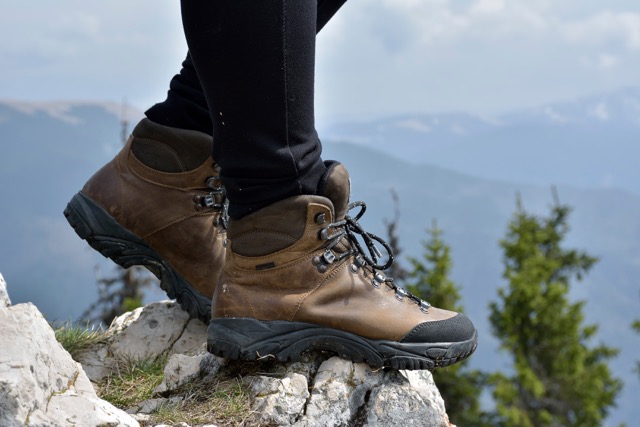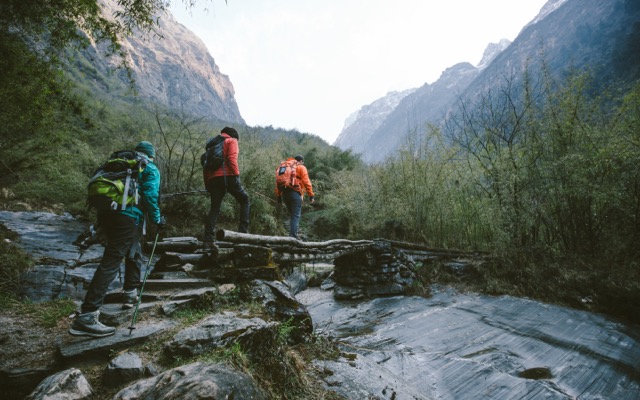If you’re a hiker, every outing is an adventure. Nobody wants to think about aches and pains but they can tarnish an otherwise great hike.
Unlike other sports, hiking feels like it shouldn’t need much preparation. It’s just walking, right? But even if you’re taking a walk on a sidewalk you should take good care of your feet before, during, and after.
Hiking puts even greater stress on your feet and ankles. You’re doing more than getting great exercise and taking in some amazing scenery. Uneven trails or ground and walking uphill (or up a mountain) set the stage for discomfort. Even a well-groomed or paved flat trail can cause painful issues when you’re out for hours.
The last thing you need on a long hike is sores or injuries. So before you set out, take some time to pamper those feet. They’ll take you everywhere you want to go with a little TLC.

Before Your Hike
Hiking Boots
You know that your everyday shoes need to be comfortable. You’ve probably looked long and hard for the right shoes to get you through the day. You should do the same thing for your hikes.
Your hiking boots or shoes need to fit well. They should be comfortable from the first time you try them on. Don’t convince yourself that an uncomfortable shoe or boot just needs to be broken in. If it hurts when you try it on, move to a different pair.
A great-fitting hiking boot has room at the front to move your toes and a good, secure heel. Your feet should not slide when you walk.
You may need to purchase insoles for your hiking boots. If you’re not sure, come and talk with our podiatrist or get help from a professional at a sporting goods store. Good arch support keeps your feet from getting tired, maintains your boots’ fit, and even helps your balance.
Don’t head out for a long hike right away in new footwear. Wear them around the house and take short walks in the neighborhood. Wear them on errands and start with short hikes. This will help the shoes to start to mold to your feet and also help your feet get used to the new footwear before taking such a long hike in them.
Inside the Hiking Boot
You’re not quite ready to hit the trail yet. Pick up some good hiking socks that are padded, breathable, and dry quickly. Try wool, nylon, or a blend and see which is most comfortable.
Now take a look at your feet. Trim your toenails properly to give you the best fit inside your boots. It seems trivial, but if your toenails are too long you could be in for a painful hike.
Get Ready to Hike
If you’re a new or inexperienced hiker, start on easier trails. There is still plenty to see without climbing a mountain. A good hiking map will tell you the difficulty of various trails.
To avoid hiking pain, stretch your feet and ankles before you begin. Just like any other sport, warming up your muscles helps you avoid injury. If you’re going to be hiking for more than one day, be sure to stretch every morning or before each hike.
Bring plenty of water. Your whole body benefits from proper hydration, even your feet. Pack a small first aid kit for your feet. Include adhesive bandages and padding like moleskin. Alcohol wipes, blister patches, and antibiotic ointment are good additions, especially for longer outings.

During Your Hike
Now that you’ve prepared, it’s time to hit the trail. Your feet will thank you for thinking of them as you hike. Find a comfortable, slow, and steady pace. You’re more likely to twist an ankle or turn a foot on uneven ground if you’re rushing.
Think about using a walking stick or hiking poles. If you’re already a hiker, you’ve certainly seen them on the trails. They help your stability and reduce the chance of foot and ankle injury.
Your goal is to enjoy the outdoors. That’s a lot easier to do when you feel steady and balanced. Practice with your equipment before you use it on a long hike.
If you start to feel any chaffing, stop and take a look at the area. Use your bandages and padding to prevent blisters. Don’t wait until after your hike to check sore spots. Catch irritation early and avoid those painful blisters.
If you do develop a blister, clean and cover it as soon as possible. A small unbroken blister is less painful and less likely to get infected than a large, open one. Blisters are the enemy of enjoyable walks and hikes. Prevention is your foot’s best friend.
Hiking foot care means listening to your body. If your feet or ankles feel strained or tired, take a break. You can avoid overuse injuries by stopping to rest. It gives you a chance to soak in a little more nature, too. Choose a quiet spot and enjoy the day.
After Your Hike
You probably feel great after a hike. Fresh air and exercise are balms for both body and soul. Let’s keep it that way. Hiking ankle care and foot care don’t end when you step off the trail.
Toward the end of your hike, slow down to give your body a chance to start its recovery. Take off your hiking boots or shoes and stretch your feet, toes, and ankles. It feels fantastic and gives those muscles room to move.
If your hike was long and your feet are tired, try a foot rub and an Epsom salt soak.
Good foot and ankle care makes every hike more enjoyable. You can prevent sores and injuries with a little preparation before your hike and some attention during and after your time on the trail.
Contact Us to Keep Foot Pain Away
If you experience hiking foot pain, let us help you get back on the trail. You may need treatment for an injury or advice about hiking boots, custom orthotics, or stretches.
Reach out today using our online contact form or call our Kalamazoo office at (269) 373-1019 or our Allegan office at (269) 673-8757. Let’s make your next hike your best hike.
